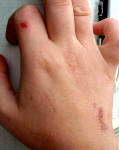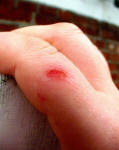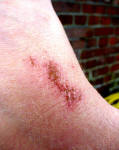Burning out silk velvet
How does ‚burning out‘ work?
Just because I think that they are necessary – some explanations first.
The burning out process (which, in some cases, is called by its french name – „Dévoré“) works with a special, chemical fluid, which is applied to the back of the velvet and are ironed after drying. Those chemicals are not exactly liquid, they have a gel like texture. READ THE INSTRUCTIONS of the burnout fluids. Some have to be mixed (from some kind of gel and something else which resembles coarse salt) and others come finished in a bottle. For the fluids that come as gel and ’salt‘, carefully read the instructions how to mix them. Mixing them the wrong way can destroy your fabric.
The chemicals only work on fabrics that are woven with both natural, protein fibers (like silk and wool) and natural, non-protein fibers (like rayon (which is a cotton derivate), cotton and linen). Silk / rayon velvet is a good example: The backing is woven with silk, the pile is rayon. Another example would, for example, be silk / rayon satin or charmeuse.
The chemical fluid will only remove the natural, non-protein fibers. That means, if you would try it on a 100% rayon or cotton velvet then you would practically burn holes into the velvet, as, of course, on those fabrics also the backing is made of those fibers.
The fluid will not at all work on non natural fibers, like polyester velvet.
The process works like this:
First, one has to apply the fluid to the back of the velvet (hint: That’s not the side with the pile!).
Fluid applied to the backing of the velvet
It helps a lot to use a template; if the velvet is still white (meaning – not dyed), then it’s very simple to use a black and white template which is placed under the fabric – as the fabric – being white – is somehow transparent, you can see your template through the fabric and work with it.
I usually use a small bottle, which is normally used to apply Gutta / outliner for silk painting onto the fabric to apply my burnout chemicals. The fact that those bottles have an extremely small tip helps a lot if I want to burn out extremely small patterns.
If anything went wrong when you apply the fluid – like, you accidentally dropped some fluid in a place where it didn’t belong, smeared some fluid or discovered that you used a template which included text, but that text was NOT mirrored (which it should be – remember, you apply the fluid to the backside of the fabric, so anything you’re applying there will be mirrored when you see it from the front!), you can still wash the fluid out with clear water, let the fabric dry and start over again.
After the fluid, which should be applied as a *thin* layer, has dried, the velvet has to be ironed from the backside. It takes a bit practice to do this right, after ironing the fluid-painted areas should have a color resembling a good toast.
If they look like a toast that has been in the toaster for too long, then you have to practice some more, either reducing the temperature of the iron or moving the iron faster – in any case of a black or just dark brown area, you can be sure that the backing will crack in this place during the first washing (which, in case of white velvet, would probably be the dye process).
If the painted areas don’t seem to change their color (meaning they stay white or just slightly yellowish), then you’ll want to increase the temperature and / or move the iron more slowly over the fabric.
As I have already said – it takes practice – so, for your own sake – take some time to practice it. Sacrifice some of your precious fabric, burnout fluid and time to practice this process – I KNOW how bad it can be if one burns a hole right into the fabric where holes are SO NOT needed.
Now – as soon as your painted and dried patterns on the fabric have gotten a nice and even toast tan, you can flip the fabric (meaning – with the velvet side up) and experience something amazing (…at least as long as you do this for the first time 😉 …):
You can use your fingernail to scratch the pile off the velvet in the places where the fluid was applied.
And before you totally panic on the thought of having to scratch all that pile from the velvet – don’t worry. The pile can, no, should better be washed off (as this process is much gentler than a fingernail scratching over backing!), so all you have to do is wash your silk velvet (or whatever fabric you might have burned out!) in the washing machine (read my notes for silk velvet in a washing machine here at the bottom of the page), which, by the way, is also a good opportunity to dye the fabric.
During the washing the loose pile over the patterns will come off and wash away – it’s really that simple! Don’t be afraid that the loose pile might damage the washing machine – it’s by far too fine for that.



I know this was posted a long time ago, but I wanted to say thanks for all the warnings. I tend to go off half-assed and this time I will take all safety precautions.
Devorant contains Potassium Dichromate, a known sensitizer, carcinogen, and mutagen. You should really be wearing a mask and gloves for this process, those burns will likely become melanoma in 20 years.
Wanted to know if you’ve worked with fiber etch yet or hints for working on black velvet. Thanks!
No, I only worked with the Dupont Devorants, since Fiber etch isn’t available where I live.
There shouldn’t be a difference between etching black or white velvet, except that you can’t see when it’s properly „toasted“ when ironing the etching. I prefer etching white velvet only and dye it after etching; that way I also make sure that the etching chemicals won’t discolor the dye of the velvet (which I guess can happen!).
Hope that helps 🙂
I’d really like to buy the burnout fluid. Could you tell me where to buy it or what the brand names are?
Sure!
Personally, I’m working with the Devorant by Dupont. I’m very satisfied with that brand.
Then, there’s also FiberEtch (mentioned on the above linked site as well), but I’ve never worked with it so I can’t say anything about it.
Both brands are available from various dealers – Google will help you find them.
Hope that helps 🙂